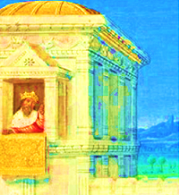 The image of Bathsheba bathing -- while David watched -- was lost when the French Army crossed over the Apennines. This image was only one page in the Book of Hours that had belonged to Louis duc d'Orleans, and it was no more revealing than the image of Venus rising from the sea that Botticelli painted ten years earlier, although it more closely resembled Titian's Venus Rising from the Sea, painted about twenty-five years later. But it was not in worldly Florence that this book of hours was found.
The image of Bathsheba bathing -- while David watched -- was lost when the French Army crossed over the Apennines. This image was only one page in the Book of Hours that had belonged to Louis duc d'Orleans, and it was no more revealing than the image of Venus rising from the sea that Botticelli painted ten years earlier, although it more closely resembled Titian's Venus Rising from the Sea, painted about twenty-five years later. But it was not in worldly Florence that this book of hours was found.
No one in Father Rene-Marie Robichau's Parish knows that although centuries ago this image inspired Giuseppe to ask the Cheesemaker's daughter to marry him, Giuseppe was not inclined to display it prominently in his household. Instead, he hid it in a ceramic box that he willed to his son.
No neighbors in Father Robichau's Parish know that if it had not been for Bathsheba, the Book of Hours that Giuseppe found might have been kept more prominently in the homes of his descendants -- where it might have been used as a family book of prayer, or spilled on by children, or eaten by a wayward goat. Whether or not for centuries Giuseppe's descendants admired this image in privacy is not known.
Niccolo, Tomasso's son, knows that after Hitler built The Gothic Line along the Northern summits of the Apennine Mountains, the influx of Nazi soldiers caused Tomasso (1890-1970) -- whose many greats grandfather Giuseppe had secreted this book of hours in a decorative waterproof box -- to hide family valuables. Tomasso did not want to bury the book of hours that contained the picture of Bathsheba. But he acquiesced when Niccolo suggested that a shop near where the American soldiers were quartered might buy it. The small amount of food allocated with ration badges was insufficient, even in farming communities; the money received could be used to buy food or clothes on the black market. Niccolo knows that this happened, but he doesn't go to Church regularly, and he seldom encounters Father Robichau.


 The image of Bathsheba bathing -- while David watched -- was lost when the French Army crossed over the Apennines. This image was only one page in the Book of Hours that had belonged to Louis duc d'Orleans, and it was no more revealing than the image of Venus rising from the sea that Botticelli painted ten years earlier, although it more closely resembled Titian's Venus Rising from the Sea, painted about twenty-five years later. But it was not in worldly Florence that this book of hours was found.
The image of Bathsheba bathing -- while David watched -- was lost when the French Army crossed over the Apennines. This image was only one page in the Book of Hours that had belonged to Louis duc d'Orleans, and it was no more revealing than the image of Venus rising from the sea that Botticelli painted ten years earlier, although it more closely resembled Titian's Venus Rising from the Sea, painted about twenty-five years later. But it was not in worldly Florence that this book of hours was found.

